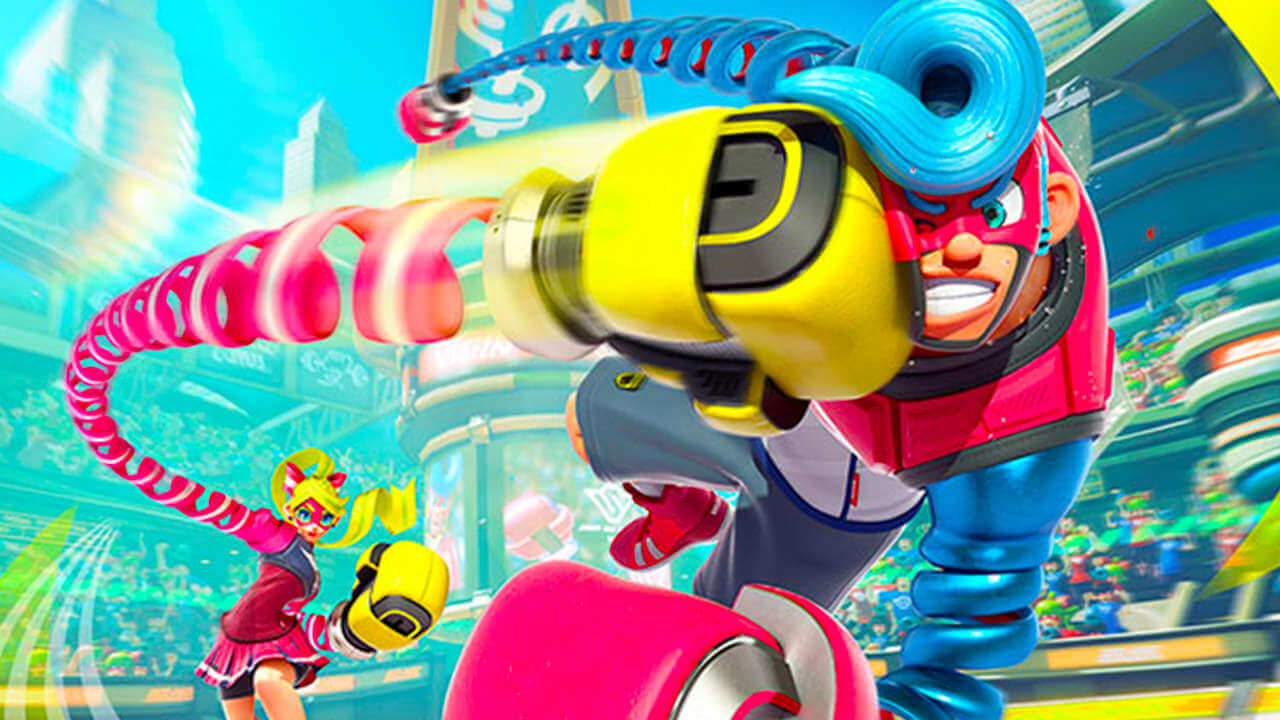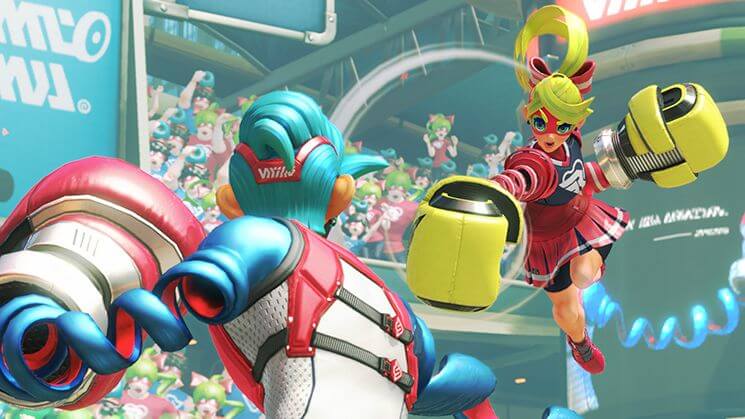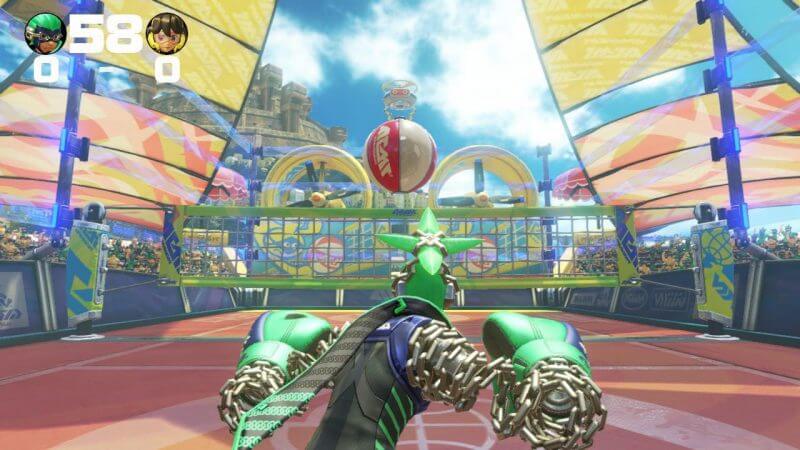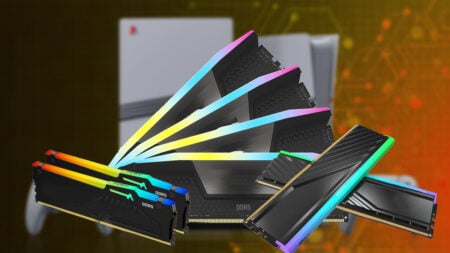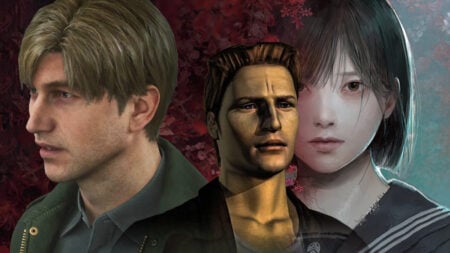Title: Arms
Available On: Nintendo Switch
Developer: Nintendo
Publisher: Nintendo
Genre: Arena Fighter
Official Site: https://arms.nintendo.com/
Release Date: June 16, 2017
Where to Buy: Nintendo eShop, Retailers
If you’ve ever held the Joycons in both hands, then using them in a virtual boxing match was likely the one of the first things you thought of. Leave it to Nintendo then, to a take a simple idea like this and polish it until it shines. ARMS manages to be as fun as it is charming, and while it would have been easy to churn out a simple and soulless boxing game built on novelty alone, ARMS stretches so much farther.
Players use spring-loaded arms to engage in a fast-paced, long-distance boxing match, dashing, jumping, and throwing punches until one player prevails. Punch with both arms to try for a high-damage grab while charging your special meter to unleash powerful Rush attacks on your opponent. With 10 distinct characters and a plethora of arms to choose from, this simple yet novel idea was wonderfully-executed, despite a few trip ups along the way.
The combat system of ARMS is deceptively simple. Achieving victory is every bit about strategic movement and reading your opponent as it is throwing punch after punch. Power-ups and bombs occasionally drop in the many arenas, making careful mid-fight positioning a priority. Every arm can be charged to add a variety of effects varying from a damaging fire blast, to a disorienting whirlwind, to an electric stun that disables your opponent’s arms.
Since players are capable of curving punches, arms with more pronounced arcs in their trajectory can be used to set opponents up for massive damage with a slower, heavier follow-up. Playing ranked I found that it was often effective to throw a wide arcing left hook, and fire a barrage of hits off to the right, as that was where my opponents most often dodged. Seeing this happen consistently, it was eventually adapted into a strategy built around baiting out a forward dash instead, leaving them wide open for a grab. This is just one example, but it’s clear that with 30 different arms and 10 different characters with different play styles, the combat can have a surprising amount of depth, while still being easy to learn. It may be mainly dashing, jumping, and punching, but the difference between a beginner and a master is immense.
Since the combat system of ARMS can be a lot for new players to take in, each character begins with only 3 arm options, serving to carefully guide a new player into that character’s most effective play style. Helix, for example, can slink down against the ground to make himself a small target, or stretch himself thin to bob around punches and grabs and punish accordingly.
It makes sense then that Helix begins with the Guardian, a defensive shield arm best used for zoning your opponent and punishing aggressive play styles. Helix also starts with a large defensive bouncing arm called the Blorb, perfect for lobbing out over the defensive wall the Guardian provides. Picking up a specific character with few available arms can teach a newcomer not only the basics of general combat but the optimal play style of whoever they want to play, which is especially important with a combat system this unconventional.
At the outset, ARMS defaults to the motion-based control scheme, which always felt as engaging as it did satisfying. It’s one thing to press a button and watch a wind-up robot cop throw a punch, and it’s another to throw the punch yourself. While the motion controls felt natural enough, they never felt as accurate as the basic controller setup. It feels like it comes down to a trade-off between the satisfaction of throwing the punch and the old familiarity of a basic controller, and while I’m sure most players will switch to the basic controller setup almost immediately, the motion controls are praiseworthy all the same.
ARMS comes with a series of game modes, some far better than others. The Grand Prix lets players test their skill level against computer controlled opponents in fights of increasing difficulty. This served as a great training exercise for learning the strengths and weakness of different characters while experimenting with different arm combinations and exploring how they synergize. The Grand Prix must be beaten at a level 4 difficulty to unlock ranked mode, and while I’m sure some players will be annoyed by this restriction, ARMS has a different enough combat system to merit an hour or so of training. Keeping players from getting crushed too early is likely well worth the minor restriction.
While the Grand Prix is great for getting the player acquainted with the characters, arenas and play styles, it’s also unfortunately filled with one-off mini-games that never felt as strong as the actual combat. Each Grand Prix contains three events that stray from the core fighting system, a mini-game centered on dunking your opponent, a ARMS variation of volleyball, and a target-breaking game called Skill Shot.
When it comes down to it the gameplay of ARMS was carefully crafted first and foremost around a 1-v-1 fight. Anything that deviates from this initial setup is going to inherently feel a little weaker than what the control system was initially designed for. On their own, these mini-games are fine inclusions, no surprise from Nintendo, the undisputed king of mini-games, but craving a fight and getting a target breaking contest will no doubt leave some players feeling a dissatisfied.
This goes for the online mode as well. While playing ranked mode players will only be matched with opponents for a straight up 1 on 1 fight, but playing unranked online involves being placed in a randomly selected game mode with a random number of players in a lobby. It feels like many players will default to the unranked online modes to hone their skills in single player combat, but unfortunately, they are equally likely to be placed in a game of V-ball instead.
Fighting with extendable arms is an exceptionally novel idea, but this novelty is reliant on a certain degree of focus on its core strengths, and a target-breaking mini-game doesn’t showcase the ARMS system like the combat does.
You’ve likely gathered from this video so far that fighting in ARMS requires a constant lock on to your opponent with all movement done relative to where that opponent is positioned. It’s easy to see then, that this system feels far less refined when fighting more than one opponent.
Whether I was in a team battle or a 3-player free-for-all, fighting multiple opponents at once always felt a little awkward. Getting grabbed from out of your peripheral because the camera heavily favors a single target never really felt fair. Your lock on can be changed with the press of a button, but this button is unfortunately mapped to the up button on the left Joycon, requiring players to take their thumb off of the movement stick to change their locked target.
This is a minor gripe because honestly, ARMS is the most fun I’ve had with an arena fighter in a long time. While the mini-games aren’t as satisfying as the combat, they’re inclusion as games to play with a few friends while not taking things too seriously makes perfect sense.
With an engaging combat system, well-designed characters, and a handful of fun game modes, ARMS felt like it took the long-distance boxing premise to its maximum potential, and in the end was a complete knockout.
Verdict: ARMS is as fun as it is innovative, taking a simple idea and fleshing it out into an exceptional arena fighter that feels like the perfect fit for the Switch Joycons. While the combat system is engaging and satisfying to master, it’s also reliant on 1-v-1 encounters to truly shine, and both team battles and the assortment of mini-games feel far weaker for this lack of focus. Regardless, ARMS is a blast, and it excels at encouraging you to hone your skills, adapt your playstyle, and punch your way to victory.
[review]

